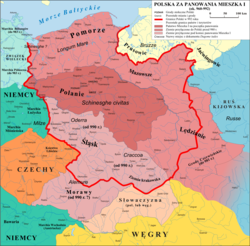Lechites
[2][3] According to Polish legend, Mieszko I inherited the ducal throne from his father who probably ruled over two-thirds of the territory inhabited by eastern Lechite tribes.
He united the Lechites east of the Oder (Polans, Masovians, Pomeranians, Vistulans, Silesians) into a single country of Poland.
Bolesław carried out successful wars against Bohemia, Moravia, Kievan Rus' and Lusatia, and forced the western Pomeranians to pay Poland a tribute.
The Sorbian languages of the southern part of the Polabian area, preserved as relics today in Upper and Lower Lusatia, occupy a place between the Lechitic and Czech-Slovak groups.
Lestko (also Lestek, Leszek), mentioned in the Gesta principum Polonorum,[6][7][8] completed between 1112 and 1118 by Gallus Anonymus, was the second legendary duke of Poland and the son of Siemowit, born ca.
The Res gestae saxonicae sive annalium libri tres chronicle of 10th-century Germany, written by Widukind of Corvey, noted that Mieszko I (son of Siemomysł and grandchild of Lestek), ruled over the tribe called the Licicaviki,[9] who lived in what is now Poland and were known as "Lestkowici" - the tribe of Lestek identified by the historians with the Lendians.


